|
|
|
Sort Order |
|
|
|
Items / Page
|
|
|
|
|
|
|
| Srl | Item |
| 1 |
ID:
113896
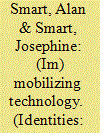

|
|
|
|
|
| Publication |
2011.
|
| Summary/Abstract |
Immobilization is generally thought to result from power and poverty acting against the acceleration produced by science and technology. In this article we explore neglected countervailing trends, such as quarantines, health inspections, and import bans, where science has the effect of restricting mobility, which we refer to as "slow science." As well as increasing mobility, science can be mobilized for political projects of restricting movement, but this possibility is neglected because of cultural assumptions fundamental to modernity. Both science and technology can be enrolled for projects of slowing mobility as well as increasing mobility. Drawing on actor-network theory, we examine the enrolment of science and technology into restricting movement in various ways. These issues are explored first through an overview of the neglected genealogy of the ways in which science and technology have slowed movement, particularly across national borders, and second through a short case study of how food safety concerns affect the movement of beef across borders. The case study discusses how "slow science" diagnoses threats posed by mobility and develops technologies to immobilize certain entities. These entities have almost always been biological organisms (including humans) or their products due to the self-reproducing qualities of invasive species, bacteria, or viruses. Uniquely, WTO rules about food require that restrictions be based on sound science, resulting in trade disputes focused on scientific interpretations.
|
|
|
|
|
|
|
|
|
|
|
|
|
|
|
|
| 2 |
ID:
113895


|
|
|
|
|
| Publication |
2011.
|
| Summary/Abstract |
In this introduction, we outline the general conceptual framework that ties the various contributions to this special issue together. We argue for the importance of anthropology to "take on" mobility and discuss the advantages of the ethnographic approach in doing so. What is the analytical purchase of mobility as one of the root metaphors in contemporary anthropological theorizing? What are the (dis)advantages of looking at the current human condition through the lens of mobility? There is a great risk that the fast-growing field of mobility studies neglects different interpretations of what is going on, or that only patterns that fit the mobilities paradigm will be considered, or that only extremes of (hyper)mobility or (im)mobility will be given attention. The ethnographic sensibilities of fieldworkers who learn about mobility while studying other processes and issues, and who can situate movement in the multiple contexts between which people move, can both extend the utility of the mobilities approach, and insist on attention to other dynamics that might not be considered if the focus is first and last on (im)mobility as such. In this special issue, we do not want to discuss human mobility as a brute fact but rather analyze how mobilities, as sociocultural constructs, are experienced and imagined.
|
|
|
|
|
|
|
|
|
|
|
|
|
|
|
|
| 3 |
ID:
143545
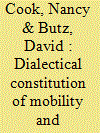

|
|
|
|
|
| Summary/Abstract |
This paper contributes to the critical mobilities literature by analysing local mobilities in Gojal, northern Pakistan in the aftermath of the 2010 Attabad Landslide, in order to develop new insights regarding the dialectical relationship between mobility and immobility. The landslide destroyed a large section of the Karakoram Highway, the region's arterial roadway. Among its disastrous effects was prolonged disruption of the accustomed movements of 20,000 villagers stranded north of the slide. To show how mobility is constituted dialectically in relation to immobility in this context, we detail the social and economic demobilisations Gojalis faced when the highway became impassable, and outline new mobilities they developed to mitigate the disaster of protracted strandedness. Gojalis responded to demobilisation by remobilising, at different scales, along new routes, in different directions and via new mobility platforms, thereby re-establishing circulation as a paradigm of everyday life and demonstrating the paper's argument that disasters are social processes that have simultaneously demobilising and remobilising effects. We conclude that nurturing a multiplicity of mobile relations and practices in several directions and across scales during the disaster recovery process will help Gojalis avoid a similar mobility disaster in the future.
|
|
|
|
|
|
|
|
|
|
|
|
|
|
|
|
| 4 |
ID:
185527
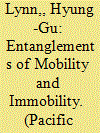

|
|
|
| 5 |
ID:
152626
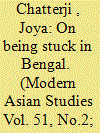

|
|
|
|
|
| Summary/Abstract |
Immobility raises awkward questions for theorists of migration. From their standpoint, migration is unusual behaviour that requires explanation. Its obverse—staying in place—is seen as an ‘obvious’ state of affairs that calls for no explanation. Yet assumptions about the ordinariness of immobility are insecure. For one thing, we know a great deal more about the mobile societies of early modern Asia; for another, Asian mobility in the era of high imperialism is much better understood. Yet despite these cumulative gains in our understanding of the scale of mobility in early-modern and modern Asia, and its acceleration in ‘the age of migration’, immobility continues to be seen as the ‘obvious’ state of affairs. This article suggests some preliminary answers to ‘the immobility paradox’, based on a study of the greater Bengal region. By analysing the impact of the intensifying links, in the late colonial era, between Bengal and the global economy, it shows that this varied widely for different people, in ways that had a profound bearing on their capacity to move. The article develops the notion of ‘deficits’ which worked to inhibit the mobility of particular groups and individuals. Physical frailty and obligations of care, it shows, were crucial factors in shaping immobility. Relations of gender and generation, and the inequalities embedded in these relations, produced ‘overabundances’—of obligations to people and places—that tied certain people down. Finally, it hints at the reasons why, and the ways in which, stayers-on have grown poorer.
|
|
|
|
|
|
|
|
|
|
|
|
|
|
|
|
| 6 |
ID:
113898
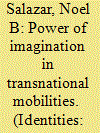

|
|
|
|
|
| Publication |
2011.
|
| Summary/Abstract |
At the roots of many travels to distant destinations, whether in the context of tourism or migration, are historically laden and socioculturally constructed imaginaries. People worldwide rely on such imaginaries, from the most spectacular fantasies to the most mundane reveries, to shape identities of themselves and others. These unspoken representational assemblages are powerful because they enact and construct peoples and places, implying multiple, often conflicting, representations of Otherness, and questioning several core values multicultural societies hold, by blurring as well as enforcing traditional territorial, social, and cultural boundaries. What are the contours of power, agency, and subjectivity in imaginaries of transnational mobility and the intersecting social categories those visions both reify and dissolve? Ethnographic studies of human (im)mobility provide an innovative means to grasp the complexity of the global circulation of people and the world-making images and ideas surrounding these movements. As a polymorphic concept, mobility invites us to renew our theorizing, especially regarding conventional themes such as culture, identity, and transnational relationships. This article critically analyzes some preliminary findings of an ongoing multisited research project that traces how prevalent imaginaries of transnational tourism to and migration from the "global South" are (dis)connected. I suggest anthropology has unique contributions to make to the current debate in the social sciences by ethnographically detailing how mobility is a contested ideological construct involving so much more than mere movement.
|
|
|
|
|
|
|
|
|
|
|
|
|
|
|
|
| 7 |
ID:
124787
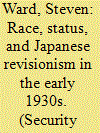

|
|
|
|
|
| Publication |
2013.
|
| Summary/Abstract |
This paper develops and illustrates a novel theoretical explanation for maximal revisionist challenges to the status quo. I argue that some rising great powers become dissatisfied with the normative and constitutive structure of the status quo and therefore incapable of or unwilling to orient themselves toward reassurance, not because of increasing capabilities but rather due to the domestic political effects produced by perceptions of status immobility-the idea that the status quo is unable to accommodate the rising state's claims to increased status and prestige. I illustrate the argument by showing that Japan's increasing revisionism after 1931 can in large part be explained by widespread perceptions of status immobility linked to Japanese understandings of the role of race in the maintenance of the Western-dominated status hierarchy.
|
|
|
|
|
|
|
|
|
|
|
|
|
|
|
|
|
|
|
|
|